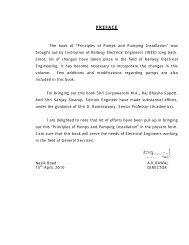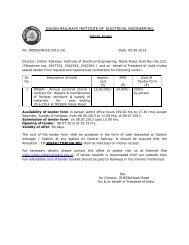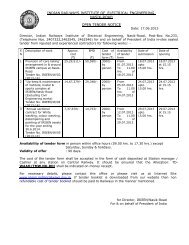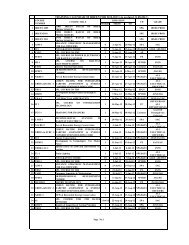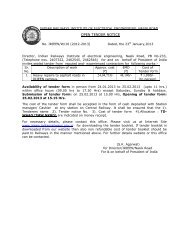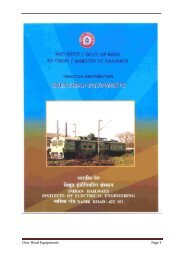remote control equipment - Indian Railways Institute of Electrical ...
remote control equipment - Indian Railways Institute of Electrical ...
remote control equipment - Indian Railways Institute of Electrical ...
Create successful ePaper yourself
Turn your PDF publications into a flip-book with our unique Google optimized e-Paper software.
light or bluish grey according to age the chief indications <strong>of</strong> weak cells are badly<br />
coloured plates, irregularity in gassing or entire failure to gas and a fall in voltage and<br />
specific gravity below that <strong>of</strong> other cells.<br />
In new batteries, flakes <strong>of</strong> brown scale will be seen getting detached from<br />
edge <strong>of</strong> positive plates. This information <strong>of</strong> scale is normal. Until all this scale is<br />
dispersed, the plate cannot be considered as stabilized. Sometimes pieces <strong>of</strong> this<br />
scale may lodge across adjacent negative plates and cause a partial short circuit.<br />
Such flaked pieces should be gently dislodged with a thin piece <strong>of</strong> wool and allowed<br />
to fall to be bottom <strong>of</strong> the cell. This scaling occurs only on the edges <strong>of</strong> the plates.<br />
The removal <strong>of</strong> the scales should be done very carefully so that the plates are not<br />
damaged.<br />
Examine carefully the physical condition <strong>of</strong> the plates such as cracks,<br />
distortions, accumulation <strong>of</strong> whitish deposits etc.<br />
The colour <strong>of</strong> the deposits gives a good indication <strong>of</strong> the state <strong>of</strong> health <strong>of</strong> the<br />
cells. Whitish deposits indicates undercharging leading to discharged condition. In<br />
healthy cells, the deposit is brown in colour but excessive shedding <strong>of</strong> active material<br />
from the positive plates indicates overcharging <strong>of</strong> the battery. If this is noticed,<br />
reduce the rate <strong>of</strong> charge immediately. If all the cells in a battery show whitish<br />
deposits immediate action should be taken to give boost charge at an appropriate<br />
rate and then to increase the trickle charging rate sufficiently to keep the battery in a<br />
healthy condition all the time. Weak cells should be immediately examined for any<br />
possible short circuit or metallic contact between positive and negative plates. The<br />
short circuit should be removed and the cell should then be given special additional<br />
charging by cutting it out and putting it back again when a healthy condition is<br />
regained, after it is attended to.<br />
3.3.6.7. Inter-cell Connectors<br />
The inter-cell connectors <strong>of</strong> the battery should be examined to ensure that<br />
they are clean and tight, making perfect contact with cell lugs and that no corrosion<br />
is taking place. Light Vaseline should be applied to prevent corrosion.<br />
Inspection <strong>of</strong> copper inter-row connectors should be made for any signs <strong>of</strong><br />
copper sulphate corrosion which should be cleaned up. Acid-pro<strong>of</strong> paint or enamel<br />
should be applied to all exposed copper work in the battery room and any flaking <strong>of</strong><br />
paint work given prompt attention.<br />
3.3.7. Protective Relays<br />
1. Each electrified division shall have specialist staff attached to the<br />
Central Repair Shop trained in the maintenance, overhauling, testing<br />
adjustment and calibration <strong>of</strong> protective relays as well as indicating,<br />
integrating and recording instruments. Such specialist staff should hold<br />
competency certificate No TR-7 as explained in Chapter XII.<br />
32






